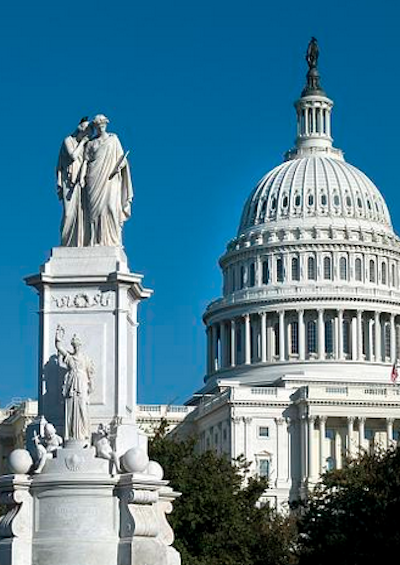Four-Wheeling in the Sky: Notes on American Infrastructure
What lessons can be learned from a train trip across America?
January 24, 2009

Amtrak offers valuable insights into Einstein’s concept of time/space continuum.
Time moves at four speeds, at least: scheduled time, actual time, changing time zones and dining car times.
For example, as the 6.30 p.m. passenger contingent out-sits and out-chews the 7 p.m. shift, the 7.30 p.m. and 8 p.m. shifts with stolid determination. We meet some interesting diners. Forty percent of our chance table companions during the trip turn out to be missionaries.
Outside of the window, white Christmas amidst Michigan steel mills is passing by, as are a few enormous casinos in-between. At Chicago’s Union Station, we have a layover after about 17 hours on the train since departing from Washington — over 700 miles away.
The only source of lunch is a grubby hole-in-the wall Chinese take-out. A barely readable sign under the greasy window boasts: “Zagat Rated” — the American Michelin Guide. While chowing down, I receive a “Merry Charismas” email on my Blackberry from someone in the Middle-East.
“The train is delayed, because there is something wrong with the locomotive. It isn’t working.” Eventually, the problem is resolved. Passengers are herded single-file by an employee wearing a Christmas hat with a flickering light bulb to an automatic door to the tracks. Alas, it won’t open.
“The door is frozen — all turn around”. From a deep armchair, a transit passenger with an Old Testament-like grey beard mutters: “The last shall be first.”
Night falls. A lady is wearing a T-shirt reading: “Eat Safely, Use Condiments”. As we near the Mississippi, the train slows to a walking pace, which it maintains for mile after mile.
This is not Amtrak’s fault, we are told over the loudspeakers, as the actual track belongs to the Burlington and Ohio Railroad. “They have been having a lot of problems with their signals,” and so “we are going to be a bit late pulling into Denver.” Darkly, the voice adds, “Sometimes forces are aligned against us.”
At long last, the train speeds up again. Hauled by three engines, the “California Zephyr” threads its way along canyon bottoms — and eventually reaches Salt Lake City.
Heading for a sushi bar we cross the Olympic Plaza shopping mall’s central square. Suddenly ice-cold water shoots up right between our legs.
Having rushed to safety, we see a tiny sign which we should not have overlooked: “Get ready to get wet! This fountain is hard to resist. Kids of all ages (even parents) play in this fountain, and it’s a great way to cool off in the summer months.” Less so on arctic winter days.
Google sheds light on the mystery: “A large stone version of the snowflake logo from the Olympics forms the shape of a ground-level fountain, which features shooting jets of water synchronized to the Olympics’ theme and other music. The ‘water dance’ goes off every 30 minutes, for 10 minutes at a stretch, though the times in between are just as much fun.” Quite so.
On the way to Moab, Utah, the temperature is 16 degrees Fahrenheit (minus 10 degrees Celsius). A road signs flicks by: “Green River Welcomes You. Celebrate Our Melons.”
Most Moab stores and restaurants close down for the winter, but there is always Eddie McStiff’s place. This sign declares: “Open Everyday, Nightly all inclusive meals for $10. $2.50 pints!”
Throughout Arches National Park and Canyonlands Park, small roads and tracks up run up and down a meandering stretch of the Colorado River. Frozen stonescapes.
Another world, of magnificent beauty in radiant sunlight or reddening dusk — orange, green and purple layers. Snow at their feet, a few tufts of grass and some shrubs breaking out here and there.
Rocks take on imaginary shapes — here an eagle, a fat pigeon, Three Wise Men, ancient Mayan ruins, Abu Simbel. There, the Burghers of Calais, some unmentionable shapes, a penitent hooded monk — it’s all a three-dimensional Rorschach test shifting with the shade.
Like a boa constrictor digging into its bed, the river embraces towering rocks, grinding them down tier by crumbly tier. Way up there runs the White Trail. On our last vacation day we decide to reach Musselman’s Arch.
Our vehicle is a tiny speck, far above the river. Slowly, slowly, we drive between cliff and chasm. The winding trail narrows. It is only two feet wider than the car.
A sharp bend hides oncoming traffic. Snow may well conceal ice. No way to back up. I tell Irene: “Don’t look down now — just look at the trail.”
A little farther along, she says, I presume in jest: “For heaven’s sake, don’t start reading your email.”
Later, with a sweeping gesture at the imminent precipice and the glorious, distant panorama, taking a hand off the wheel, I say: “I am really delighted that we are doing this on our last day,” adding, on reflection, “I mean, not literally”.
“Just stop talking, will you!” she shoots back.
Takeaways
Like a boa constrictor digging into its bed, the river embraces towering rocks, grinding them down tier by crumbly tier.
From a deep armchair, a transit passenger with an Old Testament-like grey beard mutters: "The last shall be first."
Rocks take on imaginary shapes. It's all a three-dimensional Rorschach test shifting with the shade.

